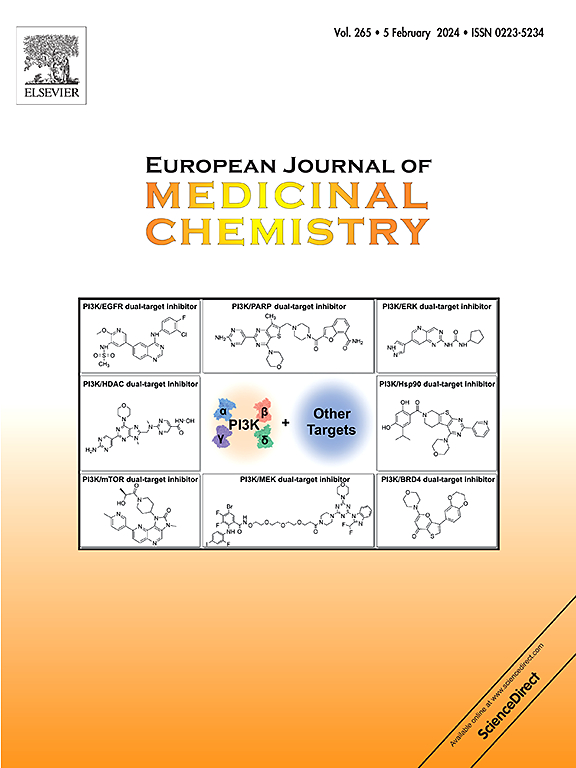靶向α4β1整合素:从环状到线性配体,化学修饰的效果。
IF 6
2区 医学
Q1 CHEMISTRY, MEDICINAL
引用次数: 0
摘要
免疫系统依靠整合素在白细胞运输过程中的粘附和迁移以及细胞内信号传导。整合素表达失调与自身免疫性疾病、炎症、癌症和感染等病理状况的发生之间存在因果关系。因此,α4β1等整合素被认为是重要的治疗靶点。本研究合成了一系列新化合物,并对α4β1的亲和力和效力、α5β1和αMβ2整合素的选择性进行了评价。3个化合物3、4和8表现出优异的结合亲和力(Ki <;10 nM)的α4β1。在细胞粘附实验中,这三种配体表现为α4β1的拮抗剂,证实了整合素介导的细胞内信号传导具有ERK1/2信号通路的功能选择性。值得注意的是,脯氨酸衍生物化合物4是α4β1的拮抗剂(IC50为15±3 nM), αMβ2整合素的激动剂(EC50为23±5 nM)。化合物2是一种氟化β-内酰胺衍生物,是α5β1的选择性强效激动剂(EC50为45.98±7.92 nM)。化合物5虽然与α4β1整合素的LDV结合位点不同,但在α4β1和α5β1整合素介导的细胞粘附(EC50分别为25±3 nM和4.8±3.4 nM)和激活α4β1整合素介导的ERK1/2和Akt磷酸化中表现出激动作用。化合物8是该系列中对α m - β2最有效的激动剂(EC50为1.4±0.2 nM)。总的来说,本研究为新的整合素配体的作用提供了新的见解,这些整合素配体可能被认为是炎症性疾病和癌症治疗应用的潜在先导化合物。本文章由计算机程序翻译,如有差异,请以英文原文为准。


Targeting α4β1 integrin: from cyclic to linear ligands, effects of chemical modifications
The immune system depends on integrins for adhesion and migration during leukocyte trafficking and for intracellular signalling. There is a causal relationship between dysregulation of integrin expression and the onset of pathological conditions, such as autoimmune diseases, inflammation, cancer, and infections. Therefore, integrins, such as α4β1, are considered important therapeutic targets. In this study, a series of novel compounds were synthesized and evaluated for affinity and potency towards α4β1, and selectivity towards α5β1, and αMβ2 integrins. Three compounds 3, 4, and 8 showed excellent binding affinities (Ki < 10 nM) for α4β1. In cell adhesion assays these three ligands behaved as antagonists of α4β1, as confirmed by integrin-mediated intracellular signalling with a functional selectivity over ERK1/2 signalling pathway. Notably, compound 4, a proline derivative, was an antagonist against α4β1 (IC50 15 ± 3 nM) and an agonist against αMβ2 integrin (EC50 23 ± 5 nM). Compound 2, a fluorinated β-lactam derivative, was a selective and potent agonist of α5β1 (EC50 45.98 ± 7.92 nM). Compound 5, although it seems to bind to a different site compared to LDV in α4β1 integrin, showed an agonist behaviour in cell adhesion mediated by α4β1 and α5β1 integrin (EC50 25 ± 3 and 4.8 ± 3.4 nM, respectively) and in activating α4β1 integrin-mediated ERK1/2 and Akt phosphorylation. Compound 8 was the most potent agonist of the series against αMβ2 (EC50 1.4 ± 0.2 nM). Overall, the present study provides new insights into the effects of new integrin ligands that could be considered as potential lead compounds for therapeutic applications in inflammatory diseases and cancer.
求助全文
通过发布文献求助,成功后即可免费获取论文全文。
去求助
来源期刊
CiteScore
11.70
自引率
9.00%
发文量
863
审稿时长
29 days
期刊介绍:
The European Journal of Medicinal Chemistry is a global journal that publishes studies on all aspects of medicinal chemistry. It provides a medium for publication of original papers and also welcomes critical review papers.
A typical paper would report on the organic synthesis, characterization and pharmacological evaluation of compounds. Other topics of interest are drug design, QSAR, molecular modeling, drug-receptor interactions, molecular aspects of drug metabolism, prodrug synthesis and drug targeting. The journal expects manuscripts to present the rational for a study, provide insight into the design of compounds or understanding of mechanism, or clarify the targets.

 求助内容:
求助内容: 应助结果提醒方式:
应助结果提醒方式:


